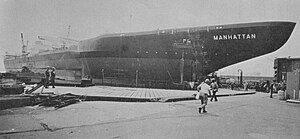SS Manhattan (1962)

SS Manhattan in 1969
|
|
| History | |
|---|---|
| Builder: | Fore River Shipyard |
| Fate: | Scrapped c.1987 |
| General characteristics as built | |
| Type: | Oil tanker |
| Tonnage: | 105,000 dwt |
| Length: | 940 ft (290 m) |
| Beam: | 132 ft (40 m) |
| Speed: | 17–18 knots (31–33 km/h; 20–21 mph) |
| General characteristics post conversion | |
| Type: | Oil tanker icebreaker |
| Tonnage: | 115,000 |
| Length: | 1,005 ft (306 m) |
| Beam: | 148 ft (45 m) |
| Draft: | 52 ft (16 m) |
| Installed power: | 43,000 shp (32,000 kW) |
| Speed: | 17 knots (31 km/h; 20 mph) |
SS Manhattan was an oil tanker constructed at the Fore River Shipyard in Quincy, Massachusetts that became the first commercial ship to cross the Northwest Passage in 1969. Having been built as an ordinary tanker in 1962, she was refitted for this voyage with an icebreaker bow in 1968–69. Registered in the United States at the time, she was the largest US merchant vessel as well as the biggest icebreaker in history.
In 1965, she was taken to Portland, Oregon via the Columbia River, to be cleaned and used to transport 50,000 tons of grain. The size and draught of the ship required careful preparations for her transit on the river.
Manhattan remained in service till 1987. After an accident in East Asia she was scrapped in China.
Manhattan's route began in August 1969 on the east coast of North America and transited the passage from east to west via the Baffin Sea and Viscount Melville Sound. The master of Manhattan was Captain Roger A. Steward. Heavy sea ice blocked the way through M'Clure Strait, so a more southerly route through Prince of Wales Strait and south of Banks Island was used. A single, token barrel of crude oil was loaded at Prudhoe Bay and then the ship went back. She was escorted by the Canadian Coast Guard icebreaker CCGS John A. Macdonald. At various times during the expedition, Manhattan was supported by the icebreakers CCGS Louis S. St-Laurent, USCGC Staten Island, and USCGC Northwind.
...
Wikipedia
